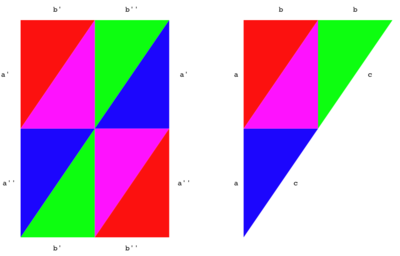Riemann-Hurwitz formula: Difference between revisions
Jump to navigation
Jump to search

imported>Michael Hardy (links to eponyms) |
mNo edit summary |
||
| (One intermediate revision by one other user not shown) | |||
| Line 1: | Line 1: | ||
{{subpages}} | |||
In [[algebraic geometry]] the '''Riemann-Hurwitz formula''', named after [[Bernhard Riemann]] and [[Adolf Hurwitz]], states that if ''C'', ''D'' are smooth [[algebraic curve]]s, and <math>\scriptstyle f:C\to D</math> is a [[finite map]] of [[degree]] ''d'' then the number of [[branch points]] of ''f'', denoted by ''B'', is given by | In [[algebraic geometry]] the '''Riemann-Hurwitz formula''', named after [[Bernhard Riemann]] and [[Adolf Hurwitz]], states that if ''C'', ''D'' are smooth [[algebraic curve]]s, and <math>\scriptstyle f:C\to D</math> is a [[finite map]] of [[degree]] ''d'' then the number of [[branch points]] of ''f'', denoted by ''B'', is given by | ||
: <math>2 (\mbox{genus}(C)-1)=2d(\mbox{genus}(D)-1)+B. \, </math> | : <math>2 (\mbox{genus}(C)-1)=2d(\mbox{genus}(D)-1)+B. \, </math> | ||
[[Image:Gludiag.png|400px|thumb|a triangulated gluing diagram for the Riemann sphere, and its pullback to a torus double cover, which is ramified over the vertices of the triangulation]]Over a [[field (algebra)|field]] in general [[Euler characteristic|characteristic]], this theorem is a consequence of the [[Riemann-Roch theorem]]. Over the [[complex numbers]], the theorem can be proved by choosing a [[triangulation]] of the curve ''D'' such that all the branch points of the map are nodes of the triangulation. One then considers the [[pullback]] of the triangulation to the curve ''C'' and computes the [[Euler characteristic]]s of both curves. | [[Image:Gludiag.png|400px|thumb|a triangulated gluing diagram for the Riemann sphere, and its pullback to a torus double cover, which is ramified over the vertices of the triangulation]]Over a [[field (algebra)|field]] in general [[Euler characteristic|characteristic]], this theorem is a consequence of the [[Riemann-Roch theorem]]. Over the [[complex numbers]], the theorem can be proved by choosing a [[triangulation]] of the curve ''D'' such that all the branch points of the map are nodes of the triangulation. One then considers the [[pullback]] of the triangulation to the curve ''C'' and computes the [[Euler characteristic]]s of both curves.[[Category:Suggestion Bot Tag]] | ||
[[Category: | |||
Latest revision as of 11:00, 12 October 2024
In algebraic geometry the Riemann-Hurwitz formula, named after Bernhard Riemann and Adolf Hurwitz, states that if C, D are smooth algebraic curves, and is a finite map of degree d then the number of branch points of f, denoted by B, is given by
Over a field in general characteristic, this theorem is a consequence of the Riemann-Roch theorem. Over the complex numbers, the theorem can be proved by choosing a triangulation of the curve D such that all the branch points of the map are nodes of the triangulation. One then considers the pullback of the triangulation to the curve C and computes the Euler characteristics of both curves.


